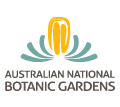 |
In Flower This WeekA weekly news-sheet prepared by a Gardens volunteerNumbers in brackets [ ] refer to garden bed 'Sections'. Plants in flower are in bold type. |
 |
In Flower This WeekA weekly news-sheet prepared by a Gardens volunteerNumbers in brackets [ ] refer to garden bed 'Sections'. Plants in flower are in bold type. |
In the garden by the bridge over the Tasmanian Rainforest Gully is Asterotrichion discolour [Section 66a], a rather straggly tree but with very delicate cream flowers. Nearby is a sign giving information about the Richea pandanifolia [Section 66a] which is growing along side.
Acacia podalyriifolia [Section 126] has been covered with golden balls of flowers for some time and is still impressive. On the opposite side of the road is Grevillea ‘Poorinda Queen’ [Section 124], with its orange spider flowers, while a little further on is Banksia spinulosa [Section 126], with orange flower spikes highlighted with reddish coloured styles.
Westringia glabra [Section 6] is a small compact plant with bluish mauve flowers while a little further on is a group of Westringia ‘Poorinda Pavane’ [Section 6] with small white flowers. Even though the mint bushes are not yet in flower, there is a distinct smell in the air here! Grevillea floribunda [Section 25] has drooping red flowers and its neighbour, Banksia robur [Section 25], has the full range of colours and flower spikes, from just coming into flower to finishing. The birds are enjoying themselves!
Banksia spinulosa var. collina [Section 27] has yellow flower spikes in all stages of flowering and then comes Banksia serrata [Section 27], of May Gibbs fame, a fine, sprawling specimen and with a seat nearby as well. Grevillea dimorpha [Section 27], a dainty grevillea with rather open foliage, has bright red flowers along its stems. Grevillea flexuosa [Section 26] has cylindrical bunches of cream flowers, some completely open while there are others yet to come. Grevillea paniculata [Section 26] is a completely different shape but also has cream flowers.
Heading back along the road, there are some specimens of Astartea ‘Winter Pink’ [Section 19], rather open plants with pale pink flowers with a darker colour in their tiny centres. Hakea sp. aff. sericea [Section 20] has reddish tinged foliage and cream flowers and, in the next bed, a group of four Hakea purpurea [Section 20] bushes are covered in large red flowers, the smaller bushes are particularly good.
In the Acacia Section on the right, Acacia baileyana (prostrate form) [Section 3] is draping itself over the small bank on which it is growing as though it was always meant to be there. The Rock Garden on the left has Persoonia linearis, [Section 15h], not in flower but with lots of striking lime green seed pods. Read the ‘Armillaria Root Rot in the Gardens’ sign on the next corner to find out more about this tree killer.
On your way back downhill, admire the successful group planting of Crowea ‘Festival’ [Section 123]. In the Queensland section of the Rainforest Gully Acmena smithii [Section 140] displays bright pink seedpods. In the small triangular bed is Epacris calvertiana var. calvertiana [Section 17] with lots of small, tubular cream flowers.
Enjoy!
Naomi Bell
| Return to: | Australian National Botanic Gardens | Previous
'In Flower' Weeks |